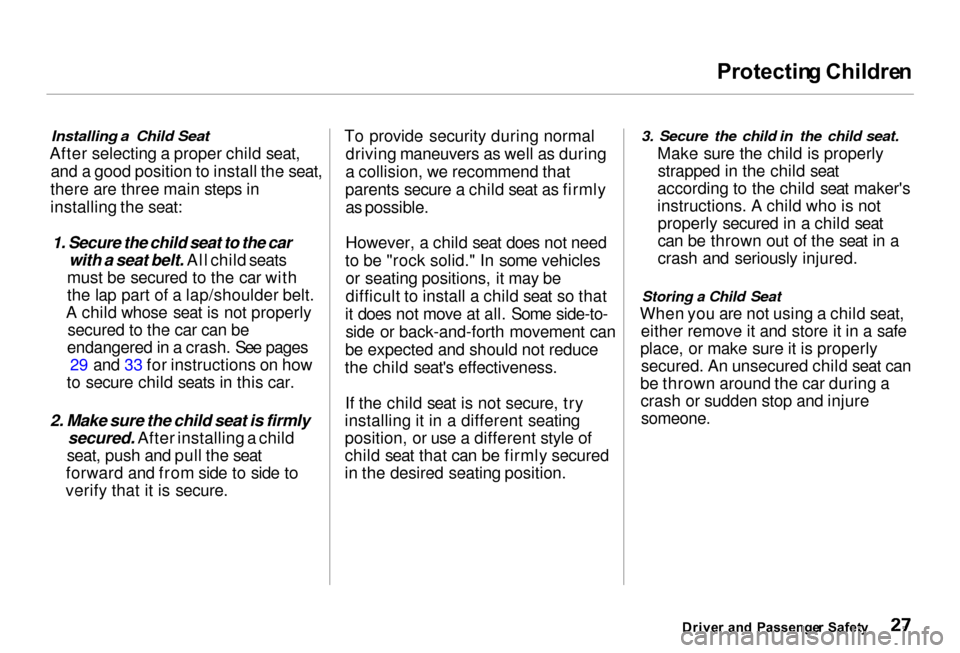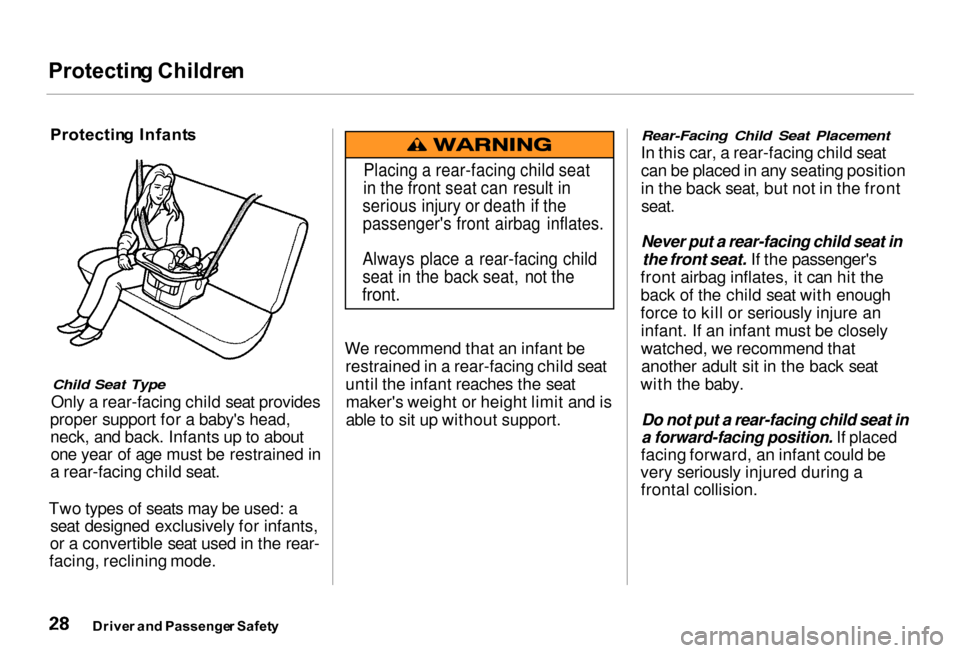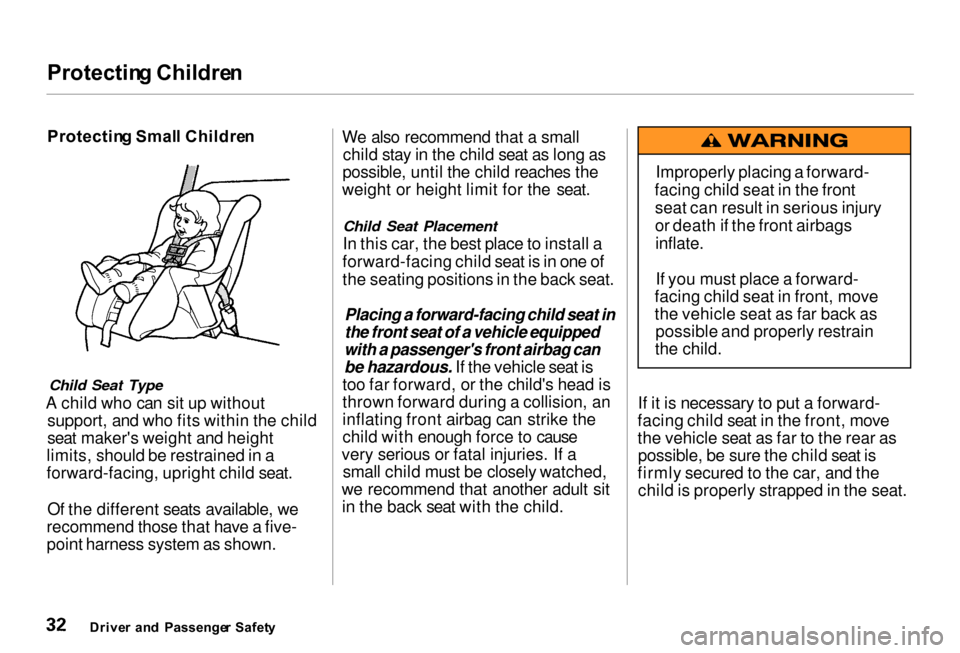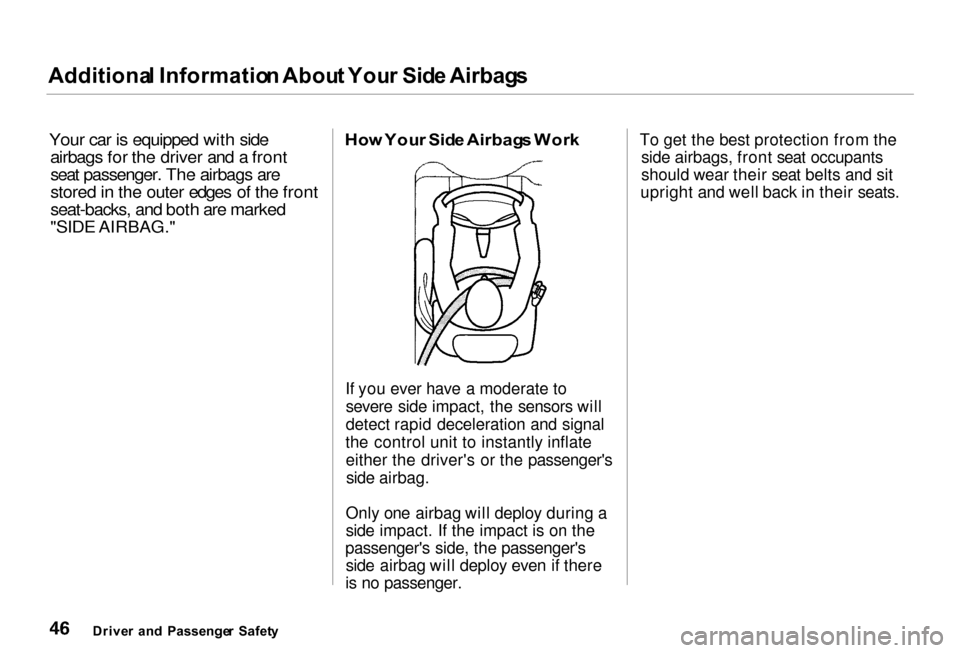seats Acura RL 2000 3.5 User Guide
[x] Cancel search | Manufacturer: ACURA, Model Year: 2000, Model line: RL, Model: Acura RL 2000Pages: 330, PDF Size: 4.53 MB
Page 29 of 330

Protectin
g Childre n
Placing a Child Seat
This page briefly summarizes Acura's recommendations on where to place
rear-facing and forward-facing child seats in your car.
Front Passenger's Seat
Infants: Never in the front seat, due
to the front airbag hazard.
Small children: Not recommended,
due to the front airbag hazard. If asmall child must ride in front,
move the vehicle seat to the rear-
most position and secure a front-
facing child seat with the seat belt (see page 32).
Back Seats
Infants: Recommended positions.
Secure a rear-facing child seat
with the seat belt (see page 28).
Small children: Recommended
positions. Secure a front-facingchild seat with the seat belt (see
page 32).
Drive r an d Passenge r Safet y
Airbag
s Pos e Seriou s
Risk s t o Childre n
The passenger's front airbag inflates with enough force to kill
or seriously injure an infant in a
rear-facing child seat.
A small child in a forward-facing child seat is also at risk. If the
vehicle seat is too far forward, or the child's head is thrown
forward during a collision, an inflating front airbag can kill or
seriously injure the child.
If a small child must ride in the
front, follow the instructions
provided in this section.
Page 30 of 330

Protectin
g Childre n
Installing a Child Seat
After selecting a proper child seat, and a good position to install the seat,
there are three main steps in
installing the seat:
1. Secure the child seat to the car
with a seat belt. All child seats
must be secured to the car with
the lap part of a lap/shoulder belt.
A child whose seat is not properly secured to the car can be
endangered in a crash. See pages 29 and 33 for instructions on how
to secure child seats in this car.
2. Make sure the child seat is firmly
secured. After installing a child
seat, push and pull the seat
forward and from side to side to
verify that it is secure. To provide security during normal
driving maneuvers as well as during
a collision, we recommend that
parents secure a child seat as firmly as possible.
However, a child seat does not need
to be "rock solid." In some vehicles or seating positions, it may be
difficult to install a child seat so that
it does not move at all. Some side-to- side or back-and-forth movement can
be expected and should not reduce
the child seat's effectiveness.
If the child seat is not secure, try
installing it in a different seating
position, or use a different style of
child seat that can be firmly secured
in the desired seating position. 3. Secure the child in the child seat.
Make sure the child is properlystrapped in the child seat
according to the child seat maker's
instructions. A child who is not properly secured in a child seat
can be thrown out of the seat in a
crash and seriously injured.
Storing a Child Seat
When you are not using a child seat, either remove it and store it in a safe
place, or make sure it is properly secured. An unsecured child seat can
be thrown around the car during a crash or sudden stop and injure
someone.
Driver an d Passenge r Safet y
Page 31 of 330

Protectin
g Childre n
Protectin g Infant s
Child Seat Type
Only a rear-facing child seat provides
proper support for a baby's head, neck, and back. Infants up to aboutone year of age must be restrained in
a rear-facing child seat.
Two types of seats may be used: a seat designed exclusively for infants,
or a convertible seat used in the rear-
facing, reclining mode. We recommend that an infant be
restrained in a rear-facing child seat
until the infant reaches the seatmaker's weight or height limit and is
able to sit up without support.
Rear-Facing Child Seat Placement
In this car, a rear-facing child seat
can be placed in any seating position
in the back seat, but not in the front
seat.
Never put a rear-facing child seat in
the front seat. If the passenger's
front airbag inflates, it can hit the
back of the child seat with enough
force to kill or seriously injure an infant. If an infant must be closely
watched, we recommend thatanother adult sit in the back seat
with the baby.
Do not put a rear-facing child seat in
a forward-facing position. If placed
facing forward, an infant could be
very seriously injured during a frontal collision.
Drive r an d Passenge r Safet y
Placing a rear-facing child seat
in the front seat can result in
serious injury or death if the passenger's front airbag inflates.
Always place a rear-facing child
seat in the back seat, not the
front.
Page 32 of 330

Protectin
g Childre n
Rear-Facing Child Seat Installation
The lap/shoulder belts in the back seats have a locking mechanism that
must be activated to secure a child
seat.
The following pages provide instructions and tips on how tosecure a rear-facing child seat with
this type of seat belt.
1. With the child seat in the desiredback seating position, route the
belt through the child seataccording to the seat maker's
instructions, then insert the latch
plate into the buckle. 2. To activate the lockable retractor,
slowly pull the shoulder part of the
belt all the way out until it stops,
then let the belt feed back into the retractor (you might hear a
clicking noise as the belt retracts).
3. After the belt has retracted, tug on it. If the belt is locked, you will not
be able to pull it out. If you can pull
the belt out, it is not locked and
you will need to repeat these steps.
Drive r an d Passenge r Safet y
CONTINUED
Page 35 of 330

Protectin
g Childre n
Protectin g Smal l Childre n
Child Seat Type
A child who can sit up without support, and who fits within the child
seat maker's weight and height
limits, should be restrained in a
forward-facing, upright child seat.
Of the different seats available, we
recommend those that have a five-
point harness system as shown. We also recommend that a small
child stay in the child seat as long as
possible, until the child reaches the
weight or height limit for the seat.
Child Seat Placement
In this car, the best place to install a
forward-facing child seat is in one of
the seating positions in the back seat.
Placing a forward-facing child seat in
the front seat of a vehicle equipped
with a passenger's front airbag can
be hazardous. If the vehicle seat is
too far forward, or the child's head is
thrown forward during a collision, an
inflating front airbag can strike the
child with enough force to cause
very serious or fatal injuries. If a small child must be closely watched,
we recommend that another adult sit in the back seat with the child. If it is necessary to put a forward-
facing child seat in the front, move
the vehicle seat as far to the rear as possible, be sure the child seat is
firmly secured to the car, and the child is properly strapped in the seat.
Drive r an d Passenge r Safet y Improperly placing a forward-
facing child seat in the front seat can result in serious injury
or death if the front airbagsinflate.
If you must place a forward-
facing child seat in front, move
the vehicle seat as far back as possible and properly restrain
the child.
Page 43 of 330

Additiona
l Informatio n Abou t You r Sea t Belt s
Sea t Bel t Syste m Component s
Your seat belt system includes lap/ shoulder belts in all five seating
positions. The front seat belts are
also equipped with automatic seat
belt tensioners.
The seat belt system alsoincludes a light on the
instrument panel to remind you and
your passengers to fasten your belts. If the driver's seat belt is not
fastened before the ignition is turned ON (II), the light will come on and a
beeper will also sound. The beeper
will stop after a few seconds, but the light will stay on until the driver'sseat belt is fastened. Lap/Shoulde
r Bel t
This seat belt has a single belt that goes over your shoulder, across yourchest and across your hips.
To fasten the belt, insert the latch plate into the buckle, then tug on the
belt to make sure the buckle is
latched.
To unlock the belt, push the red
PRESS button on the buckle.
Guide the belt across your body to
the door pillar. After exiting the car,
be sure the belt is out of the way and
will not get closed in the door.
All seat belts have an emergency locking retractor. In normal driving,the retractor lets you move freely in
your seat while it keeps some tension on the belt. During a collisionor sudden stop, the retractor
automatically locks the belt to help
restrain your body.
The seat belts in all seating positions except the driver's have an additional
locking mechanism that must be activated to secure a child seat. (See
pages 29 and 33 for instructions on
how to secure child seats with this
type of seat belt.)
Drive r an d Passenge r Safet y
Page 49 of 330

Additiona
l Informatio n Abou t You r Sid e Airbag s
Your car is equipped with side airbags for the driver and a front
seat passenger. The airbags are
stored in the outer edges of the front
seat-backs, and both are marked
"SIDE AIRBAG." Ho
w You r Sid e Airbag s Wor k
If you ever have a moderate to severe side impact, the sensors will
detect rapid deceleration and signal
the control unit to instantly inflate either the driver's or the passenger'sside airbag.
Only one airbag will deploy during a
side impact. If the impact is on the
passenger's side, the passenger's side airbag will deploy even if there
is no passenger. To get the best protection from the
side airbags, front seat occupants
should wear their seat belts and sit
upright and well back in their seats.
Drive r an d Passenge r Safet y
Page 96 of 330

Sea
t Adjustment s
See pages 12 — 14 for important safety
information and warnings about how to
properly position seats and seat-backs.
Make all seat adjustments before
you start driving.
Your Acura has power adjustments for both front seats. The two powerseat adjustment switches are on the
outside edge of the seat bottom.
You can adjust the power seats with the ignition switch in any position. Driver'
s Sea t Adjustment s
The long horizontal switch adjusts the seat bottom in several directions.
The short vertical switch adjusts the seat-back angle.
Push the horizontal switch forward
or backward to move the seat
forward or backward. Pull up or push down on the front of
the switch to move the seat bottom's
front edge up or down. Pull up or
push down on the rear of the switch
to move the rear of the seat bottom up or down.
CONTINUED
Instrument s an d Control s
Page 105 of 330

Drivin
g Positio n Memor y System , Sea t Heater s
To stop the system's automatic ad-
justment; Press any button on the control
panel: MEMO, 1 or 2. Push any of the adjustment
switches for the seat or steering
wheel. Shift out of Park.
Adjust the outside mirrors.
If you select a memorized position
without inserting the key in the ignition switch, only the seat and
outside mirrors will adjust. To get
the system to also adjust the steering
wheel, insert the key in the ignition switch. You will hear two beeps
when it is complete. If desired, you can use the adjust-
ment switches to change the posi-
tions of the seat, steering wheel or outside mirrors after they are in
their memorized position. To keep
this driving position for later use,
you must store it in the driving posi-
tion memory. Sea
t Heater s
SEAT HEATER S
Both front seats are equipped with seat heaters. The ignition switch
must be ON (II) to use them. Push
the front of the switch, HI, to rapidly heat up the seat. After the seat
reaches a comfortable temperature,select LO by pushing the back of the
switch. This will keep the seat warm.
Instrument s an d Control s
Page 106 of 330

Sea
t Heaters , Sk i Sleev e
The HI or LO indicator lights and remains lit until you turn it off by
pushing the opposite side of the switch lightly. The indicator will turn
off.
In HI, the heater turns off when the
seat gets warm, and turns back on
after the seat's temperature drops. It
continues to cycle as long as you
leave it set on HI. The HI indicator
remains lit as a reminder that you
have the heater on.
In LO, the heater runs continuously.
It does not cycle with temperature
changes.
Because of the sensors for the side
airbag system, there is no heater in
the passenger's seat-back. Follow these precautions whenever
you use the seat heaters:
Use the HI setting only to heat the
seats quickly. Select the LO
setting when the seats feel warm.
The HI setting draws large amounts of current from the
battery.
Do not use the seat heaters, even
on the LO setting, if the engine is
left idling for an extended period.
They can weaken the battery, causing hard starting. Sk
i Sleev e
The ski sleeve allows you to cany skis or other long objects safely
without soiling or damaging the interior of your car. It attaches to the
trunk pass-through.
KNO B
To use the ski sleeve: 1. Pull down the rear seat armrest. Open the trunk pass-through
cover by sliding the knob down-
ward and pulling on the cover.
Instrument s an d Control s
LI
D
CONTINUED